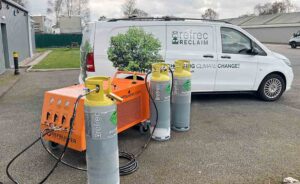A new twist on refrigeration
11th October 2019
USA/CHINA: An international team of researchers from the University of Texas at Dallas and Nankai University, China, has discovered a new refrigeration technology based on twisting and untwisting fibres.
The team claims to have demonstrated twist-based refrigeration using materials as diverse as natural rubber, ordinary fishing line and nickel titanium wire.
“Our group has demonstrated what we call twistocaloric cooling by changing the twist in fibres. We call coolers that use twist changes for refrigeration twist fridges,” said Dr Ray Baughman, director of the Alan G MacDiarmid NanoTech Institute at UT Dallas.
The effect of stretching and unstretching a rubber band is known as elastocaloric cooling.
“This elastocaloric behavior of natural rubber has been known since the early 1800s. But to get high cooling from a rubber band, you have to release a very large stretch,” Baughman said. “With twistocaloric cooling, we found that all you have to do is release twist.”
The Experiments
Baughman’s research teams previously developed artificial muscles made by tightly twisting and coiling fibres that range from carbon nanotube yarns to ordinary nylon thread and polyethylene fishing line.
In the current work, the scientists stretched rubber fibres, then twisted them until they not only coiled, but also supercoiled. Fast release of the twist resulted in surface temperature cooling of 15.5ºC. Releasing both the twist and the stretch from the rubber produced even higher cooling of 16.4ºC.
The twistocaloric cooling also worked for fishing line. The researchers inserted twist into a nonelastic polymer fishing line until coils formed. Stretching the coiled fibre caused heating, while stretch release produced a maximum surface cooling of 5.1ºC.
“By employing opposite directions of twist and coiling, we engineered fibres that cool when stretched,” said Baughman. “This is quite unusual behavior since ordinary materials heat up when stretched.”
To understand the cooling effect, the researchers used X-ray crystallography to look at what was happening at a molecular level. “We found that releasing stretch from a coiled fibre results in partial conversion of a low entropy phase into a high entropy phase,” said Baughman’s co-researcher Dr Zunfeng Liu, a professor in the State Key Lab of Medicinal Chemical Biology in the College of Pharmacy at Nankai University in Tianjin.
Cooling
Large reversible cooling is also said to have been achieved by removing twist from nickel titanium wires and by unplying bundles of these wires. A maximum surface cooling of 17ºC was observed when the researchers untwisted a single wire. Unplying a four-wire bundle produced even higher cooling of 20.8ºC.
The researchers placed a three-ply nickel titanium wire cable in a device they built that cooled a stream of water by up to 7.7ºC when the cable was untwisted. “By using further cycles of twist and twist release, much higher cooling can be achieved,” Liu said.
In another set of experiments, they coated the different types of fibres with thermochromic paint, which changes color in response to temperature variations produced by twisting fibres or stretching coiled fibres. Such fibres could be used for remotely readable sensors of strain and twist, as well as for colour-changing textiles for clothing.
“Many challenges and opportunities exist on the path from these initial discoveries to the commercialization of twist fridges for diverse large- and small-scale applications,” Baughman admitted.
“Among the challenges are the need to demonstrate refined devices and materials that provide application-targeted cycle lifetimes and efficiencies by recovering part of the inputted mechanical energy. The opportunities include using performance-optimised twistocaloric materials, rather than the few presently studied commercially available candidates.”







